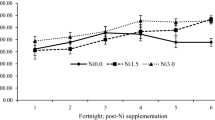Abstract
This experiment was conducted to investigate the effect of dietary arsenic (As) levels on growth performance, serum biochemistry, and the retention of iron, copper, and zinc in tissues of growing and finishing pigs. Ninety-six crossbred pigs were randomly allotted to four dietary treatments. The corn-soybean basal diets were supplemented with 0, 10, 20, and 30 mg As/kg. Arsenic trioxide was used as the arsenic source. The feeding experiment lasted for 78d. The results showed that the high arsenic diet decreased average daily gain (ADG) (p<0.05) and increased feed gain ratio (F/G) (p<0.05). Arsenic intake significantly increased (p<0.05) serum γ-gultamyltransferase (GGT), glutamic-pyruvic transaminase (GPT), and alkaline phosphatase (ALP) activities, and decreased (p<0.05) total protein, urea nitrogen, creatinine, and triglycerides. Glutamic-oxalacetic transaminase (GOT) activity, albumin, and cholesterol were not affected (p>0.05). Arsenic feeding elevated (p<0.05) liver and kidney copper concentration, but reduced (p<0.05) copper concentration in heat, bile, and lymphaden of intestine mesentery. There were increases in iron levels in liver, bile, spleen, thymus, and pancreas in pigs fed the high As diets (p<0.05), but iron contents in kidney, heart, and serum were decreased by the arsenic treatment (p<0.05). Zinc concentrations were increased (p<0.05) in liver, kidney, and thymus of pigs with arsenic treatment, but decreased (p<0.05) in bile and lymphaden of intestine mesentery. This study suggested that high dietary As levels could alter serum biochemical parameters and the retention of copper, iron, and zinc in the viscera of growing and finishing pigs.
Similar content being viewed by others
References
M. F. Hughes, Arsenic toxicity and potential mechanisms of action, Toxicol. Lett. 133, 1–16 (2002).
B. K. Mandal and K. T. Suzuki, Arsenic round the world: a review, Talanta 58, 201–235 (2002).
J. C. Ng, J. P. Wang, and A. Shraim, A global health problem caused by arsenic from natural sources, Chemosphere 52, 1353–1359 (2003).
L. L. Morrison and E. R. Chaves, Selenlum-arsenic interaction in the weanling pigs, Can. J. Anim. Sci. 63(1), 239–246 (1983).
G. L. Czarnecki and D. H. Baker, Reduction of liver copper concentration by the organic arsenical, 3-nitro-4-hydroxyphenylarsonic acid, J. Anim. Sci. 60(2), 440–450 (1985).
Shiguang Yu and A. C. Beynen, High arsenic raises kidney copper and lows plasma copper concentrastions in rats, Biol. Trace Element Res. 81, 63–70 (2000).
E. O. Uthus, High dietary arsenic exacerbates copper deprivation in rats, J. Trace Elements Exp. Med. 14, 43–55 (2001).
X. Q. Pan, L. F. Wang, H. J. Liu, et al. Effects of arsenic on some biochemical indices in experimental mice, Endemic Dis. Bull. 15(3), 10–11 (2000).
D. Nandi, R. C. Patra, and D. Swarup, Effect of cysteine, metinoine, ascorbic acid and thamine on arsenic-induced oxidative stress and biochemical alterations in rats, Toxicol. 211, 26–35 (2005).
B. Elsenhans, G. Schmoolke, K. Kolb, J. Stokes, and W. Forth, Metal-metal interactions among dietary toxic and essential trace metals, Ecotoxicol. Environ. Safety 14, 275–287 (1987).
G. Schmolke, B. Elsenhaus, C. Ehtechami, and W. Forth, Arsenic-copper interaction in the kidney of the rat. Human Exp. Toxicol. 11, 315–321 (1992).
E. Hove, C. A. Elvehjem, and E. B. Hart, Arsenic in the nutrition of the rat, Am. J. Physiol, 124, 205–212 (1938).
J. T. Skinner and J. S. McHargue, Supplementary effects of arsenic and manganese on copper in the synthesis of hemoglobin, Am. J. Physiol. 145, 500–506 (1946).
K. R. Mahaffey, S. G. Capar, B. C. Gladen, and B. A. Fowler, Concurrent exposure to lead, cadmium, and arsenic: effects on toxicity and tissue metal concentrations in the rat, J. Lab. Clin. Med. 98, 463–481 (1981).
AOAC, Official Methods of Analysis, 15th ed., Assoc. Official Analytical Chemists, Washington, DC (1990).
S. C. Wang, Food Hygiene Testing and Technology Handbook, Chemical Industry Press, Beijin, China, pp. 185–189, 1994.
S. Maiti and A. K. Chatterjee, Differential response of cellular antioxidant mechanism of liver and kidney to arsenic exposure and its relation to dietary protein deficiency, Environ. Toxicol. Pharmacol. 8, 227–235 (2000).
J. A. Cohen, and M. M. Kaplan, The SGOT/SGPT ratio: an indicator of alcoholic liver disease, Digestive Dis. Sci. 24, 835–841 (1979).
J. J. Reichling and M. M. Kaplan, Clinical use of serum enzymes in liver disease, Digestive Dis. Sci. 33, 1601–1604 (1988).
G. Hunder, J. Schaper, O. Ademuyiwa, and B. Elsenhans, Species differences in arsenic-mediated renal copper accumulation: a compaparison between rats, mice and guiniea pigs, Hum. Exp. Toxicol. 18, 699–705 (1999).
O. Admuyiwa, B. Elsenhans, P. T. Nguyen, and W. Forth, Arsenic-copper interaction in the kidney of the rat; influence of arsenic metabolites. Pharmacol, Toxicol. 78, 154–160 (1996).
G. K. Davis and W. Mertz, Copper, in Trace Elements in Human and Animals nutrition, Vol. 1, W. Mertz, ed., Academic, San Diego, pp. 301–364 1987.
C. T. Wang and W. T. Chang, Arterial tissue of arsenic, selenium and iron in blackfoot disease patients, Clinical Chem. Lab. Med. 39(7), 645–648 (2001).
A. Albores, J. Koropatnick, M. G. Cherian, and A. J. Zelazowski, Arsenic induces and enhances rat hepatic metallothionein production in vivo, Chem-Biol Inter 85, 127–140 (1992).
Author information
Authors and Affiliations
Rights and permissions
About this article
Cite this article
Wang, L., Xu, Z.R., Jia, X.Y. et al. Effects of dietary arsenic levels on serum parameters and trace mineral retentions in growing and finishing pigs. Biol Trace Elem Res 113, 155–164 (2006). https://doi.org/10.1385/BTER:113:2:155
Received:
Revised:
Accepted:
Issue Date:
DOI: https://doi.org/10.1385/BTER:113:2:155




